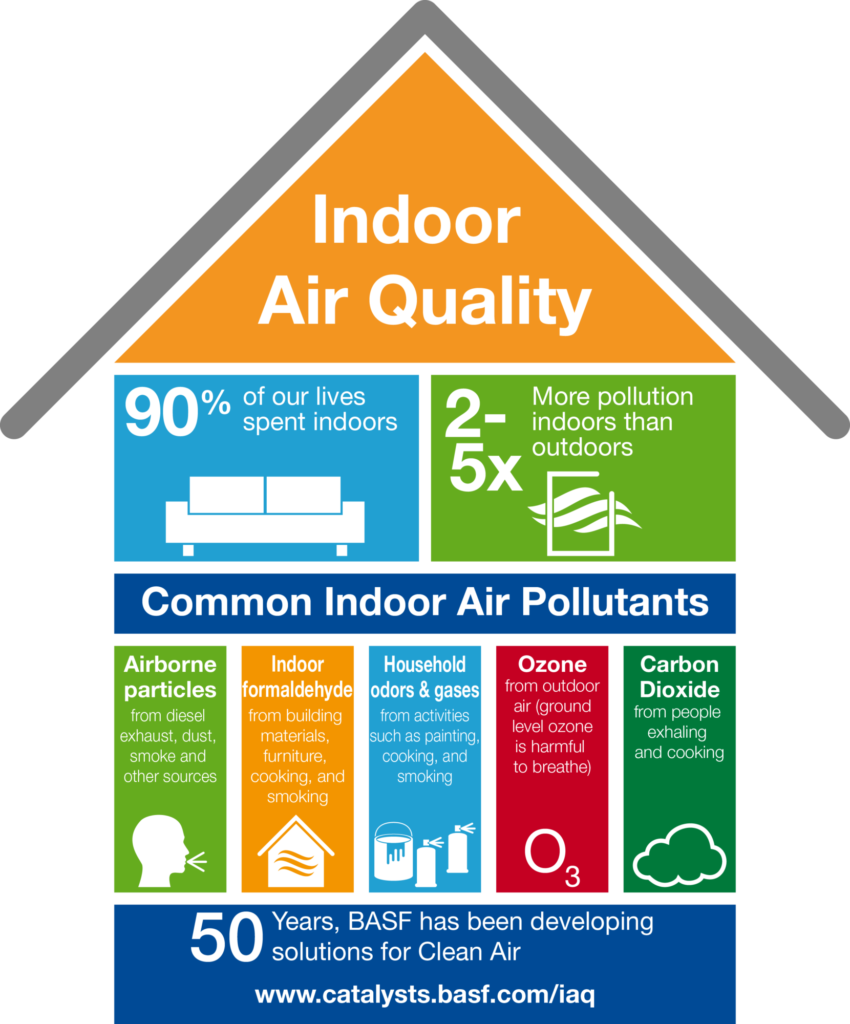Indoor air quality plays a crucial role in our overall health and well-being, significantly impacting our daily lives. With the average American spending nearly 90% of their time indoors, understanding the implications of indoor air pollution becomes more important than ever. Poor air quality can lead to a range of health effects, from respiratory issues to decreased cognitive function, which can hinder productivity in workplaces. Fortunately, improving indoor air quality is achievable through effective ventilation strategies and air filtration systems, ensuring we breathe cleaner air. By focusing on the benefits of good air ventilation, we can create healthier environments that support both physical health and mental clarity.
The atmosphere within our enclosed spaces—homes, offices, and schools—has a profound effect on general wellness and occupational efficiency. Often referred to as the health of our indoor environment, this concept encompasses various factors that contribute to our comfort and ability to perform tasks effectively. When addressing the deleterious effects of subpar air conditions, or indoor air pollution, we open the door to numerous opportunities for enhancement, including the adoption of better ventilation systems. A keen understanding of how air quality influences everyday life helps us recognize the importance of fostering spaces that promote energetic living and productive work experiences. Therefore, prioritizing indoor air quality is essential for maintaining a thriving atmosphere, both personally and professionally.
Understanding Indoor Air Quality and Its Impact on Health
Indoor air quality (IAQ) refers to the condition of the air within buildings and structures, particularly as it relates to the health and comfort of the occupants. Poor IAQ can lead to indoor air pollution, which can cause a variety of health issues, ranging from mild irritations to serious respiratory diseases. Studies have shown that people spend about 80-90% of their time indoors, making the quality of indoor air particularly crucial. Contaminants like dust, mold, and volatile organic compounds (VOCs) can accumulate inside our homes and workplaces, exacerbating allergies and other health problems.
Furthermore, the health effects of indoor air quality can manifest in numerous ways, including headaches, fatigue, and difficulty concentrating. According to research conducted at Harvard, increasing air ventilation rates within buildings can significantly enhance workers’ cognitive function and overall well-being. This is particularly relevant in office settings, where poor air quality has been linked to decreased productivity and increases in sick days, highlighting the importance of maintaining high IAQ standards.
The Dangers of Indoor Air Pollution
Indoor air pollution is often overlooked, yet it poses significant risks to our health. Common sources of indoor air pollutants include cleaning products, pesticides, and even second-hand smoke. These contaminants can lead to lengthy exposure-related health issues, including chronic respiratory diseases and heart problems. One of the main contributors to poor indoor air quality is insufficient ventilation, which traps pollutants and can lead to a buildup of harmful particles.
Moreover, awareness of how indoor air pollution affects health has increased in recent years, emphasizing the need for better air quality management. For instance, studies show that unpleasant odors and high levels of carbon dioxide can significantly impair cognitive function. Therefore, improving indoor air quality should be a priority for any building manager or homeowner, as it can mitigate health risks and enhance the overall living and working conditions.
Improving Indoor Air Quality: Effective Strategies
There are several effective strategies to improve indoor air quality that can significantly enhance health and comfort. One of the most impactful methods is to increase natural ventilation, which allows fresh air to circulate and dilute indoor air pollutants. Opening windows, using exhaust fans, and installing air exchange systems can effectively reduce airborne contaminants, particularly in areas with high traffic such as offices and schools.
In addition to enhancing ventilation, using high-efficiency air filters can also be beneficial. HEPA filters, for example, are effective at removing pollutants like dust and allergens from the air. Regular maintenance of HVAC systems, including changing and cleaning filters, is essential to ensure they are functioning optimally and not contributing to indoor air pollution. By implementing these improvements, occupants can enjoy the combined benefits of good air quality, including better health outcomes and enhanced productivity.
Benefits of Good Air Ventilation
Good air ventilation is vital for maintaining a healthy indoor environment. It not only helps eliminate stale air but also reduces the concentration of indoor air pollutants. By ensuring that fresh air enters indoor spaces, building owners can create a more comfortable atmosphere for occupants. Effective ventilation systems can significantly lower the levels of harmful substances, thus minimizing health risks associated with prolonged exposure to poor air quality.
Moreover, the benefits of good air ventilation extend beyond mere health improvements; they can also influence overall worker productivity. Studies indicated that when ventilation rates are improved, employees tend to perform better cognitively, demonstrating a marked increase in focus and problem-solving abilities. In the long run, better air quality translates to reduced absenteeism and higher job satisfaction, making a compelling case for investing in robust ventilation systems.
Air Quality and Worker Productivity
The relationship between air quality and worker productivity is profound and increasingly recognized in workplace design. High levels of indoor air pollution can impair cognitive function, leading to decreased worker efficiency and higher rates of errors. In contrast, environments that prioritize good indoor air quality promote not only physical health but also enhance mental acuity, fostering an atmosphere conducive to innovation and creativity.
Research shows that improvements in air ventilation not only benefit individual health but also translate to organizational success. Companies that invest in better indoor air quality see tangible benefits in employee performance, which directly impacts financial outcomes. This symbiotic relationship highlights the importance of prioritizing IAQ in workplaces, creating not only a healthier workforce but also a more successful business model.
Frequently Asked Questions
What are the health effects of indoor air pollution?
Indoor air pollution can lead to a variety of health issues, including respiratory problems, allergies, fatigue, and even long-term conditions like asthma or heart disease. Poor indoor air quality can exacerbate existing health conditions and impact overall well-being.
How can I improve indoor air quality in my home?
To improve indoor air quality, consider using air purifiers, increasing ventilation by opening windows, using non-toxic cleaning products, and regularly changing HVAC filters. Adding houseplants can also help filter the air and enhance indoor air quality.
What are the benefits of good air ventilation in the workplace?
Good air ventilation in the workplace is crucial for enhancing indoor air quality, which can improve worker productivity, reduce absenteeism, and increase cognitive function. Proper ventilation helps to dilute indoor pollutants and circulate fresh air.
How does indoor air quality affect worker productivity?
Research indicates that poor indoor air quality can significantly lower worker productivity due to distractions like odors, fatigue, and respiratory issues. In contrast, improved indoor air quality leads to better focus and efficiency among employees.
What is the connection between indoor air quality and health?
There is a strong link between indoor air quality and health. Poor air quality can lead to immediate health effects, such as headaches and irritation, and long-term exposure can increase the risk of chronic illnesses. Ensuring good indoor air quality is essential for maintaining health.
How much of indoor air is contaminated from outside sources?
A significant portion of indoor air can be contaminated by outdoor air pollution, with studies showing that anywhere from 30% to 50% of the indoor air can come from outside sources, including traffic and industrial emissions.
What steps can be taken to reduce indoor air pollution?
To reduce indoor air pollution, regularly ventilate your space, avoid smoking indoors, use exhaust fans, control humidity levels, keep HVAC systems maintained, and use air purifiers fitted with HEPA filters.
Can indoor air quality affect children’s health?
Yes, indoor air quality has a profound impact on children’s health. Poor air quality can contribute to developmental issues, respiratory illnesses, and can aggravate conditions like asthma, making it vital to ensure a clean indoor environment.
How do indoor air quality issues relate to mold growth?
Indoor air quality issues can create an environment conducive to mold growth, which thrives in damp conditions. High humidity levels and insufficient ventilation can lead to mold spores being airborne, posing health risks like allergies and respiratory issues.
What are common sources of indoor air pollution?
Common sources of indoor air pollution include tobacco smoke, stale air, excess dust, mold, pet dander, volatile organic compounds (VOCs) from paint and cleaning products, and combustion appliances like gas stoves. Regular cleaning and adequate ventilation can help mitigate these sources.
| Question Number | Question | Answer Choices |
|---|---|---|
| 1 | How much of their lives do Americans on average spend indoors? | 80%, 65%, 90%, 75% |
| 2 | Which workplace change boosted workers’ cognitive function in a 2015 Harvard study? | Switch to open office layout, Building increased air ventilation, Water filters installed in the kitchen |
| 3 | Building air ventilation rates shifted in the 1970s, with the main goal of: | Reducing asthma attacks, Improving cognitive function, Limiting complaints related to body odors, Preventing transmission of influenza |
| 4 | Where do you breathe most outdoor air pollution? | Outdoors, Indoors |
| 5 | If you live in an apartment, how much of the indoor air is coming from your neighbor’s apartment? | 0%, 1%, 9%, 30% |
| 6 | How many opportunities can you identify to make this building healthier? | 3, 5, More than 10 |
| 7 | How much of the air you breathe indoors just came out of the lungs of others in the room? | |
| 8 | Actions you can take to reduce the spread of infectious diseases indoors: | Bring in more outdoor air, Increase the level of filtration, Use portable air cleaners with HEPA filters, All of the above |
| 9 | Dust is hormonally active. True or false? | True, False |
| 10 | Of the 80,000-plus chemicals available for commerce, how many have been banned by the EPA since 1976? | 200, 6, 33 |
Summary
Indoor Air Quality is critical to ongoing health and well-being. Understanding how the environments where we spend the majority of our time can affect our health gives us the power to make informed decisions about our living and working spaces. The insights gained from this quiz not only highlight the importance of ventilation and air purification but also stress the impact of indoor pollutants on respiratory health and cognitive performance. By addressing indoor air quality issues, we can create healthier environments that support productivity and well-being.



